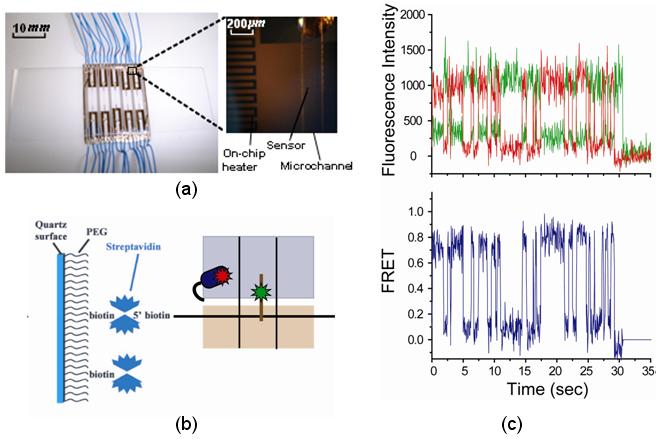| People | Research |
|
Temperature-dependent
behavior of single molecules Thermodynamic characterization methods have traditionally been applied only to an ensemble of biomolecules. Ensemble measurements, which are performed to a large population of biomolecules, allow assessment of averaged properties of biomolecules. On the other hand, there are many circumstances in basic and applied biological studies where it is desirable to obtain statistical information about thermodynamically relevant properties of single molecules. We have been exploring this opportunity in a collaboration with Professor Ruben Gonzalez in the Department of Chemistry at Columbia. To overcome the limitations of direct heat measurements, we use fluorescent methods to sensitively detect thermally induced single-molecule conformational changes. A single-molecule fluorescent resonant energy transfer (smFRET) platform embedded with temperature-controlled microchannels has been developed for measurement of single molecules. The platform has been applied to enable temperature-dependent single-molecule studies of tRNA-mRNA translocation through the ribosome. During experiments, the temperature inside the microfluidic channel was controlled in closed-loop using the MEMS thermal transducers, while the fluorescent traces of single fluorophores were recorded and analyzed by smFRET. Early results from this study suggest that the kinetic properties (e.g. translocation lifetime) of tRNA-mRNA translocation through the ribosome are strongly temperature dependent, and this dependency reveals the trend that the tRNA-mRNA translocation in ribosome strengthens with temperature. These results, while in agreement with bulk measurements, yield valuable insights into single molecules that are not available from ensemble measurements.  (a) Image of a real device and a temperature-controlled microfluidic channel; (b) surface functionalization scheme and ribosome translocation mechanism; and (c) representative Cy3 (green) and Cy5 (red) emission intensities (top) and the corresponding FRET trajectory ICy5/(ICy3+ICy5) (bottom).
|